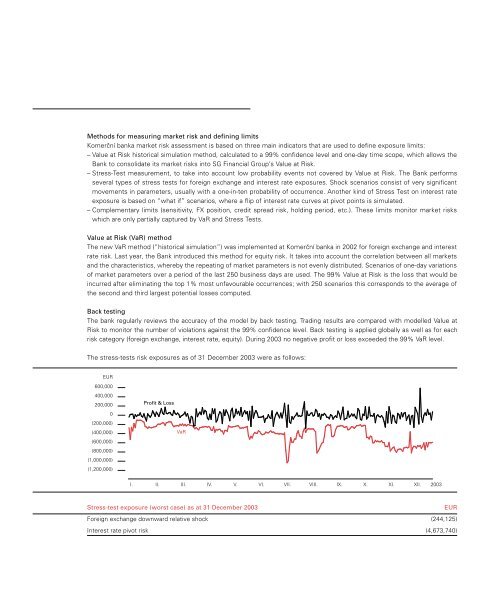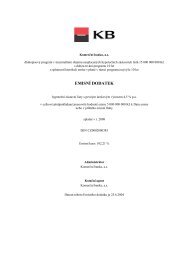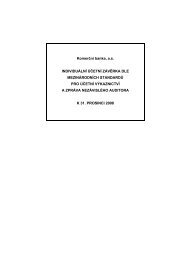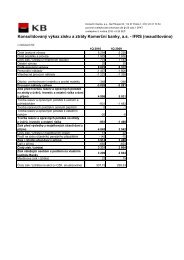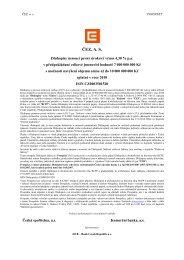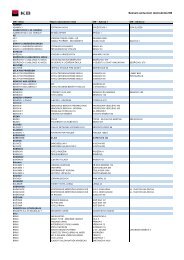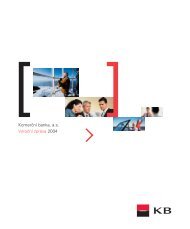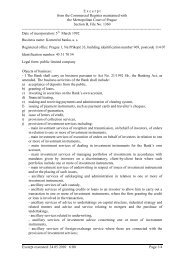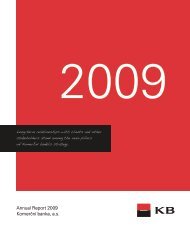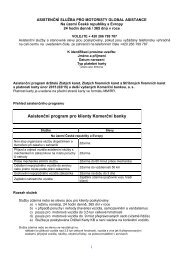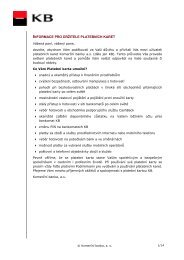KB prezent. angl - Komerční banka
KB prezent. angl - Komerční banka
KB prezent. angl - Komerční banka
Create successful ePaper yourself
Turn your PDF publications into a flip-book with our unique Google optimized e-Paper software.
Methods for measuring market risk and defining limits<br />
<strong>Komerční</strong> <strong>banka</strong> market risk assessment is based on three main indicators that are used to define exposure limits:<br />
– Value at Risk historical simulation method, calculated to a 99% confidence level and one-day time scope, which allows the<br />
Bank to consolidate its market risks into SG Financial Group’s Value at Risk.<br />
– Stress-Test measurement, to take into account low probability events not covered by Value at Risk. The Bank performs<br />
several types of stress tests for foreign exchange and interest rate exposures. Shock scenarios consist of very significant<br />
movements in parameters, usually with a one-in-ten probability of occurrence. Another kind of Stress Test on interest rate<br />
exposure is based on “what if” scenarios, where a flip of interest rate curves at pivot points is simulated.<br />
– Complementary limits (sensitivity, FX position, credit spread risk, holding period, etc.). These limits monitor market risks<br />
which are only partially captured by VaR and Stress Tests.<br />
Value at Risk (VaR) method<br />
The new VaR method (“historical simulation”) was implemented at <strong>Komerční</strong> <strong>banka</strong> in 2002 for foreign exchange and interest<br />
rate risk. Last year, the Bank introduced this method for equity risk. It takes into account the correlation between all markets<br />
and the characteristics, whereby the repeating of market parameters is not evenly distributed. Scenarios of one-day variations<br />
of market parameters over a period of the last 250 business days are used. The 99% Value at Risk is the loss that would be<br />
incurred after eliminating the top 1% most unfavourable occurrences; with 250 scenarios this corresponds to the average of<br />
the second and third largest potential losses computed.<br />
Back testing<br />
The bank regularly reviews the accuracy of the model by back testing. Trading results are compared with modelled Value at<br />
Risk to monitor the number of violations against the 99% confidence level. Back testing is applied globally as well as for each<br />
risk category (foreign exchange, interest rate, equity). During 2003 no negative profit or loss exceeded the 99% VaR level.<br />
The stress-tests risk exposures as of 31 December 2003 were as follows:<br />
EUR<br />
600,000<br />
400,000<br />
200,000<br />
0<br />
(200,000)<br />
(400,000)<br />
(600,000)<br />
(800,000)<br />
(1,000,000)<br />
(1,200,000)<br />
Profit & Loss<br />
VaR<br />
I.<br />
II.<br />
III.<br />
IV.<br />
V.<br />
VI.<br />
VII.<br />
VIII.<br />
IX.<br />
X.<br />
XI.<br />
XII. 2003<br />
Stress-test exposure (worst case) as at 31 December 2003<br />
EUR<br />
Foreign exchange downward relative shock (244,125)<br />
Interest rate pivot risk (4,673,740)


